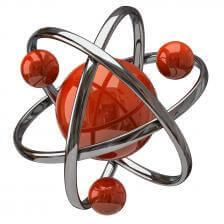What Is Resonance?
Ask Science discusses how physicists, chemists, and writers use the word “resonance” differently. Plus, how to shatter a glass with just the sound of your voice.
Lee Falin, PhD
Listen
What Is Resonance?
Sometimes when speaking about a book or movie that they really enjoyed, people will say something like, “Wow, that really resonated with me.” They usually mean that the message of the book or film caused them to feel some emotional response. The amazing writing teacher David Farland even wrote a book about this phenomenon called Drawing on the Power of Resonance in Writing to help other authors understand this response..
But just like other words we commonly use, resonance can mean something slightly different to scientists than it does to everyone else. Even more confusing is the fact that resonance can mean something different to different scientists, depending on what branch of science they study. So let’s see if we can shed some light on this multifaceted word.
Resonance in Physics

If you pull a string on a guitar, it starts to vibrate at a certain frequency called its natural frequency. The natural frequency of an object depends upon its physical and chemical properties. That is, its shape and length as well as what it is made of (steel, nylon, sheep intestines, etc.)
Recall also from our lesson on sound that the vibrating guitar string pushes against the surrounding air molecules, causing them to vibrate. Those molecules push against the ones next to them, and so on, until the vibrating molecules reach your ear drum. These poor air molecules are vibrating at the same frequency as the guitar string.
Now let’s say you have another object sitting close by that has the same natural frequency as the guitar string. Once the vibrating air molecules (which are again, vibrating with the same frequency as the string) strike this second object, that object will also start to vibrate. This induced vibration is called resonance.

Another area where resonance is often mentioned in physics is the infamous Tacoma Narrow bridge collapse. This bridge is often used as the textbook example of how not to build bridges. According to many sources, strong winds hit the bridge with the same natural frequency as the bridge itself, causing resonance which build in strength until the bridge collapsed. It’s a nice story, but most physicists don’t believe it had anything to do with resonance. Instead they blame something called aerostatic elasticity.
Resonance in Chemistry

A Lewis structure shows each atom, designated by its atomic symbol, with straight lines indicating the bonds between the atoms. Little dots are used to show free valence electrons in the molecule.
However some molecular structures can have multiple ways to draw them, depending upon where the free electrons happen to be sitting. In chemistry, this is called resonance.
Conclusion
So now you know some important ways that the word resonance differs between physicists, chemists, and writers. You also know that you can shatter a glass by placing it on a bridge during a windstorm, even though that might not actually be caused by resonance.
If you want to learn more about resonance in writing, check out David Farland’s fantastic book, Drawing on the Power of Resonance in Writing. Once you read it, you too will be able to write books and screenplays which cause sympathetic vibrations and alternate molecular arrangements in your readers.
If you liked today’s episode, you can become a fan of Ask Science on Facebook or follow me on Twitter, where I’m @QDTeinstein. If you have a question that you’d like to see on a future episode, send me an email at everydayeinstein@quickanddirtytips.comcreate new email.
Playing guitar, atom, and chemistry lab images courtesy of Shutterstock.

